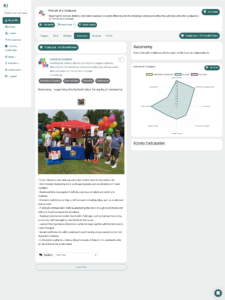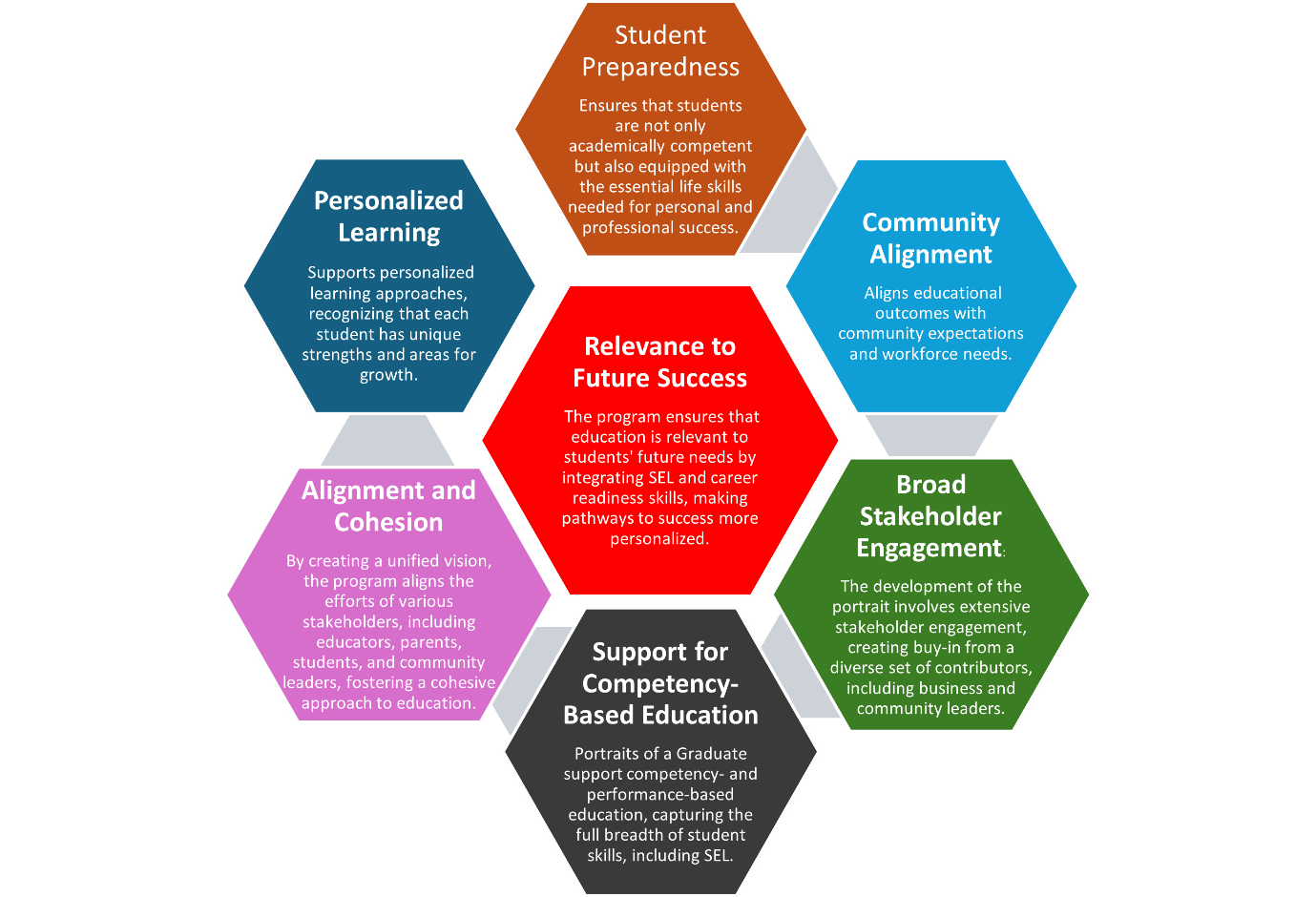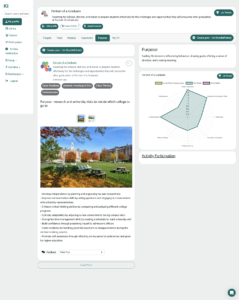Overview
The U.S. Portrait of a Graduate program provides a visionary framework for student success, aimed at preparing young people for the multifaceted challenges of adulthood. This comprehensive initiative defines the essential skills and competencies that students should develop by the time they graduate to ensure they are well-equipped for careers, higher education, and active community participation, and so success in life. Kloodle, the fully customisable digital skills and character platform, aligns perfectly with the Portrait of a Graduate program, offering innovative tools to record and showcase student achievements, thereby supporting the holistic personal development outlined in each state’s educational goals.
Kloodle enables each student to build their personal profile, based on the specific Portrait of a Graduate framework adopted by their school, through uploading evidence of their development in the form of documents, photos and videos, so providing yet more substance and context to demonstrate the individual’s progress. An example of a personal profile is below:
What is ‘POG’?
The “Portrait of a Graduate” program is a statewide initiative in each participating state in the U.S. designed to articulate a comprehensive vision in that state for what constitutes student success. This program has been developed through collaboration among state education agencies (SEAs), school districts, communities, and families, and defines the skills, mindsets, and competencies that students should possess upon high school graduation.  These skills include academic proficiency, social and emotional learning (SEL), and civic characteristics, all aimed at preparing students for life beyond school in careers, postsecondary education, personal lives, and active community participation.
These skills include academic proficiency, social and emotional learning (SEL), and civic characteristics, all aimed at preparing students for life beyond school in careers, postsecondary education, personal lives, and active community participation.
By establishing a clear, shared vision, the Portrait of a Graduate program helps guide school districts in identifying and fostering the essential competencies students need to thrive in adulthood.
Key Components of a Portrait of a Graduate Program
Examples of the core competencies for the “Portrait of a Graduate” can be derived from commonly cited attributes and skills emphasised by various educational districts across the various states that have adopted this framework. The key components can be grouped into key areas:


Implementation Strategies
The Portrait of a Graduate program emphasizes community involvement by engaging stakeholders such as parents, local businesses, and community leaders in its development and support. It integrates the identified competencies into the existing curriculum through projects, assignments, and real-world learning experiences. This isn’t like a one-off test at the end of a course, but an ongoing process of development.
Potentially, there can be a number of challenges to setting up a successful program, which participating organisations need to address. Some schools struggle with resource allocation; ensuring there are sufficient resources and support for effective implementation. Other schools encounter difficulty in designing a one-size-fits-all model that meets diverse needs. On top of this, character building and skills’ development are qualitative exercises, and the testing involves subjective assessment.
The Portrait of a Graduate Program: A Picture Paints a Thousand Words on Kloodle
Professional development is provided to train teachers and staff to effectively support and cultivate students’ skills’ development. The program also focuses on assessment and feedback, evaluating skills and providing constructive feedback to help students grow. Additionally, there is a commitment to continuous improvement by regularly reviewing and updating the program to meet the evolving needs of students and the community.
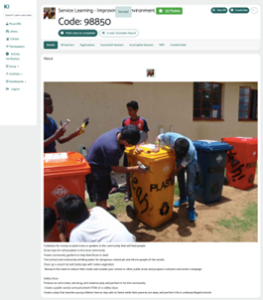 Examples Across the United States
Examples Across the United States
Many states across the U.S. have adopted the Portrait of a Graduate program, each tailoring the structure to reflect local priorities and stakeholder inputs. Here are some examples:
- North Carolina: Assesses the skills and mindsets identified in its portrait to ensure students are future-ready.
- Utah and Washington: Align their state accountability systems with the competencies and mindsets described in their portraits, integrating these into broader educational policies and practices.
Schools can then develop a program to represent their own slant:
- Fairfax County Public Schools (Virginia): Emphasis on the development of communicator, collaborator, ethical and global citizen, creative and critical thinker, and goal-directed and resilient individual.
- Albemarle County Public Schools (Virginia): Focus on lifelong learning competencies, such as mastering knowledge, developing creative thinking, and exhibiting resilience and self-management.
These state-specific implementations demonstrate a commitment to ensuring that education systems not only meet academic standards but also prioritize the holistic development of students.
What Are the Benefits of the Program?
The Portrait of a Graduate program offers several significant benefits, including:

Integrating Kloodle: The Digital Skills and Character Platform
Given the comprehensive nature of the Portrait of a Graduate program, integrating tools that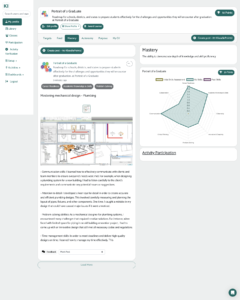 support the recording and demonstration of essential skills is crucial. Kloodle, the well-established, global digital skills and character platform, offers an ideal solution. Kloodle allows students to document and showcase their skills, achievements, and experiences in a digital portfolio format. This ultimately can be shared with potential employers and postsecondary institutions if the student wants.
support the recording and demonstration of essential skills is crucial. Kloodle, the well-established, global digital skills and character platform, offers an ideal solution. Kloodle allows students to document and showcase their skills, achievements, and experiences in a digital portfolio format. This ultimately can be shared with potential employers and postsecondary institutions if the student wants.
Crucially for the Portrait of a Graduate program, where, as mentioned above, each state tailors the structure to reflect local priorities and stakeholder input, Kloodle is fully customisable and can easily align and fit with each state’s particular program components and nomenclature.
Benefits of Using Kloodle for Portrait of a Graduate:

In Summary
The Portrait of a Graduate program represents a significant step towards a holistic, future-oriented education system, aiming to prepare students for the complexities of the modern world by focusing on a comprehensive set of skills and attributes. By defining clear competencies and engaging a broad range of stakeholders, it aligns educational efforts with the needs of students and the demands of future working life. Integrating the digital tool Kloodle further enhances the program’s effectiveness, ensuring that students not only acquire essential skills but can also demonstrate and leverage these skills in their future endeavors. Through such comprehensive and collaborative approaches, the education system can better prepare students to succeed in all aspects of their lives.